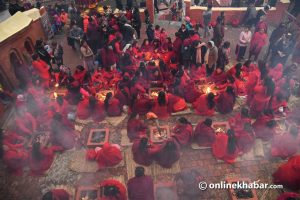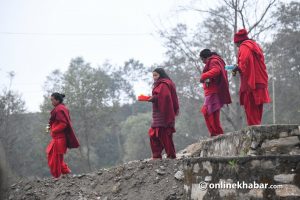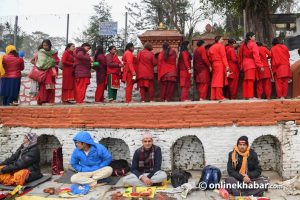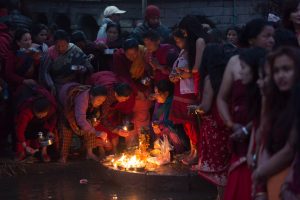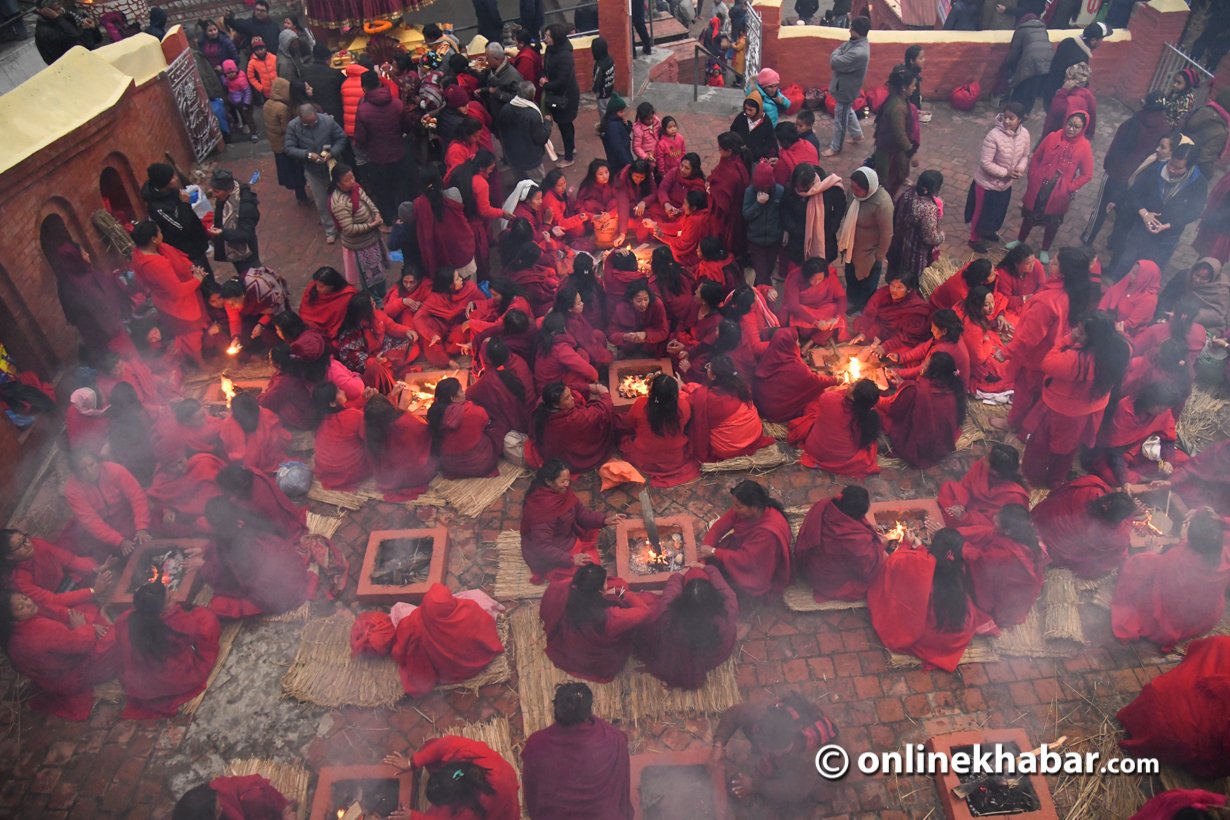
For most of the Hindu households in Nepal, the Swasthani Brata Katha needs no introduction. This religious text, a compilation of mythological stories about the goddess Swasthani and other Hindu gods and goddesses becomes a part of daily life for an entire month every year. Whereas the monthlong ritual is quite popular in Nepali villages, of late many Nepali feminists have questioned the text’s relevance arguing it is apparently patriarchal and sexist.
Jessica Vantine Birkenholtz, a scholar of gender and religion from the United States, studied the tradition multiple times in order to interpret it from a feminist perspective and found both perceptions of the tradition, as a patriarchal custom and an embodiment of the feminine power, were valid. Besides her dissertation ‘Seeking Swasthani: The Politics of Gender, Location, Iconography, and Identity in Hindu Nepal’, she has published a book titled ‘Reciting the Goddess: Narratives of Place and the Making of Hinduism in Nepal’. A winner of the American Academy of Religion Award for Excellence in the Study of Religion in the Textual Studies category in 2019, Birkenholtz is currently an associate professor of Asian Studies and Women’s, Gender, and Sexuality Studies in Pennsylvania State University.
Onlinekhabar recently talked to Birkenholtz about her observations of the ritual, its historical development and its patriarchal and feminine agenda. Excerpts have been edited for brevity.
Where did you first hear about the goddess Swasthani? Why did you decide to research it further?

I heard about the goddess when I was in Nepal for the first time in 1996. I read about her in a book and even did a month-long project while I was doing an abroad programme under my undergraduate degree. But I only started researching the Swasthani traditions and Katha in detail, years later, for my dissertation. The research began roughly in 2003, but the majority was between 2004 and 2006.
The reason why I decided to delve into the topic is that it brought together my interests in women and their traditions. Another reason was that the goddess though being a household name is not known outside Nepal. Neither are there enough manuscripts of the tradition or existence outside Swasthani Brata Katha in Nepal. She is an enigma, very complicated, yet crucial in the study of Hinduism.
My work was motivated not by an interest in Swasthani as a goddess per se, but in the Swasthani Brata Katha, as a 16th century Hindu devotional tradition that was focused on women and still widely celebrated in the modern period. Moreover, the text has changed considerably between the 16th and 21st centuries so I was interested in understanding what these textual changes were and what they could tell us about Nepal’s social, cultural, and religious history and identity.
Can you please explain in brief how you dealt with this ‘exotic’ topic?
My focus was on the historical developments of the Swasthani Brata Katha so the majority of times, during the initial phases in the research, I spent my time in libraries including Kaiser Library, National Archives, and Asha Saphu Kuthi. Then I spent significant time in Sankhu too. During this, I was able to collect and read manuscripts of the Swasthani Brata Katha. I came across many texts, around 800 of them, among which I examined about 125 manuscripts and closely read about two dozens of them, which were dated, in good shape and complete.
In the course of my research, I also met and interviewed many of the locals including Prabin Raj Shrestha, scholars Aishwarya Dhar Sharma and Kashi Nath Tamot, language scholars Jwala Sthapit Tuladhar, and local historian Prakash Man Shrestha who really helped me understand the text and the importance of the culture. They also helped me connect and communicate with many other people whom I interviewed during the research.
I also learned Nepali, Nepal Bhasa and Sanskrit languages. And I got several opportunities to closely observe the Swasthani Brata Katha and the related rituals. Though I did not take the fast, I stayed with the women there who were taking the fast in Sankhu; I used to get up with them, follow them and observe all the rituals, to really understand the culture.
There was a fair share of problems to deal with too. The access to some resources… they were not available easily, and the ongoing ‘load-shedding’ schedule (scheduled power outage) and Maoists insurgency, all had to be taken into consideration. It was all a painstakingly long process yet the most insightful.
What were your personal observations of the Swasthani Brata Katha? What fascinated you during your research?
When asked about Hindu texts, Ramayana and Mahabharata might be the most common or famous texts anyone relates to, outside Nepal. Yet in my research, Swasthani textbook was and is on a par with or even more important than the two epics, or any other Puranas and Vedas.
Figuring out the meaning for her name on its own was difficult and its connection to rituals or stories was interesting. The lack of iconography, visual depiction of the goddess outside modern times and the confusion among people considering Madhav Narayan idols as Swasthani (in Sankhu) were also intriguing.
What was interesting about the textual evidence, in particular, was that we can see a shift. The first 200 years of the tradition were about Goma, Chandrawati, Navaraj and Swasthani. After that, three major additions can be found. The first is the story of Shiva and Parvati; the second is the narrative of Vishnu including Madhu-Kaitabha and the creation of the universe. The third is the stories about Vrinda, Kamadev and others.
And due to this shift of narrative two-thirds of the stories today are of Shiva and only the latter part of the story is about Swasthani. Comparing the texts in Nepal Bhasa and Nepali, Nepal Bhasa texts are more heterogeneous while the Nepali language texts are more in number. But both have influenced the establishment of Hindu identity and patriarchy.
So have you found any evidence that suggests this shift in the narratives?
There is no concrete evidence as to why there is a shift in the narrative. Yet if we are to compare the dates of the manuscripts, printed versions of the book, the language it was written in, to that of the historical developments in Nepal or even India, we can see some hints. The texts suggest that Swasthani was first written in Nepal Bhasa (early as 693 Nepal Sambat or around 1573 AD) by Jayanta Dev when the Newar kings were prominent rulers in the Kathmandu Valley.
But from the early 19th century, we can see Nepali versions of Swasthani; that coincides with the Shah rulers in the Valley and the British Empire’s influence in India. Though nothing is concrete here, we can just speculate that; maybe because of this, there has been the shift and additions to the narrative in Swasthani Brata Katha. The changes may reflect the focus on something more than the Nepal Mandala and the influence of socio-political changes.
Having said that, the stories of the goddess Swasthani herself, her role in the story and her importance or even the rituals that the pilgrims undertake during the brata (in Magh) have not changed, neither have their beliefs.
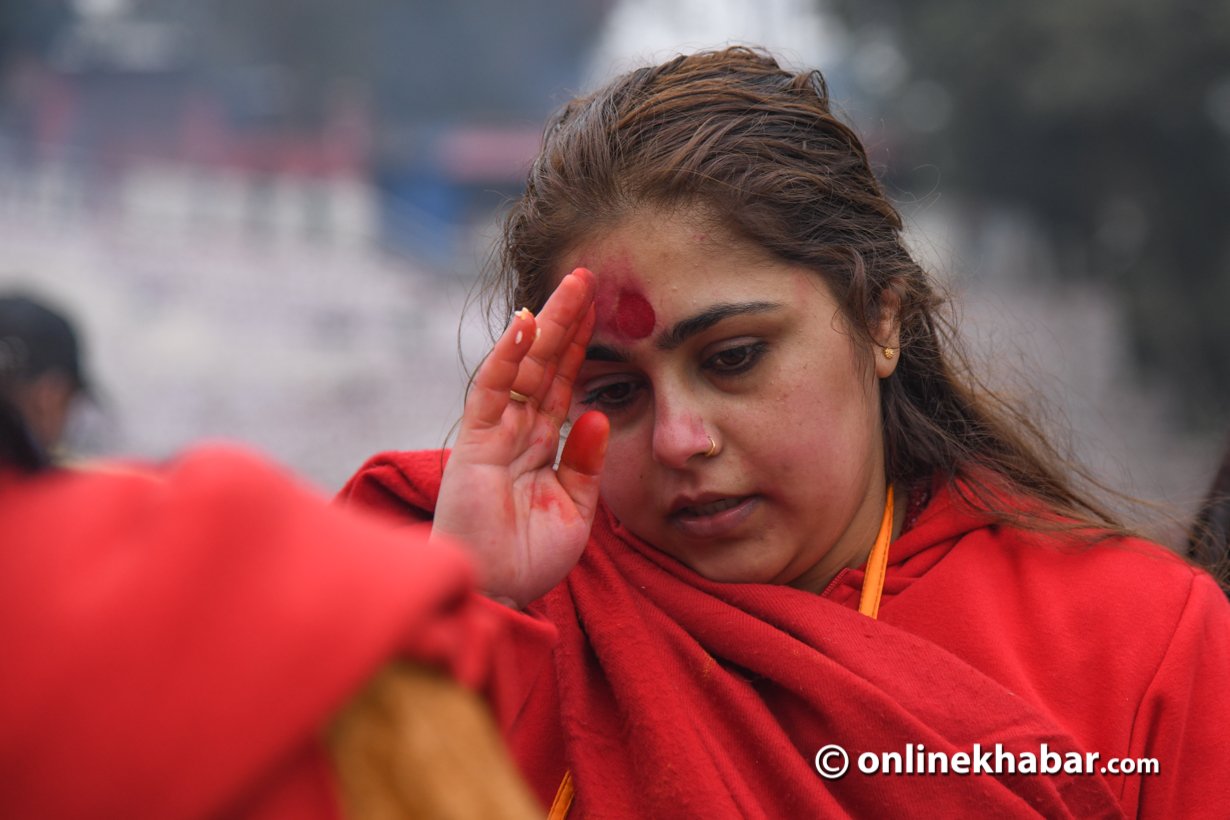
Speaking of her pictures, you have mentioned in your book that the “portrayal of the goddess is surprising as independent and unfettered by a male companion”. Why and in what ways, did you say that?
In mythologies, the women are portrayed in two major forms; one where they are calm, benign and benevolent, and always with a consort or a husband like Parvati and Saraswati, and second where they are unmarried without a male consort, but fierce and warriors like Durga and Kali. But the goddess Swasthani is a very complicated figure and quite different from all. She is calm and composed, yet described as a fierce unforgiving figure in Chandrawati’s story.
For most of the people, she does not have a prominent male consort; there is no explicit association to Shiva. But in the Katha, she is depicted as a consort of Lord Shiva. She can be seen pictured with Lord Shiva (on a statue at Makkhan) but the popular picture of her transformed and is now of her sitting on a lotus flower between the Astamatrika (like in Sankhu).
If we are to look at the Swasthani Brata Katha from a feminist perspective, how would you define it?
When it comes to the story, it has received many criticisms that the stories inside it are too patriarchal as they endorse Sati Devi’s self-immolation for her husband, Goma’s early marriage, and Vrinda’s rape. And there are people who believe that the stories are empowering, see the journey from struggle to success, and accept the traditions. It will depend on how you look at it. It is important to understand where the person is speaking from, which aspects of the story they are relating to, what empowers them or what they disagree to.
But the stories (mostly in Nepali), as I perceive it, are more of a written document of hegemonic Brahmin narratives written by Brahmin men, for Brahmin men. They do not really speak out any women-centric voice. This also goes back to the influence of Hindu, Brahman culture and influence from the rulers.
So, as a feminist myself, from a personal point of view, I do not see Swasthani as a feminist story. And as an analyst, I struggle to think if anyone reads the story and does not question it critically, will it be okay? Or say if they think “it is our culture, so that’s how it should be”, will it be okay?
Recently, there has been a new narrative of Ramayana from the eyes of Sita, as Sitayana. I would like to see a feminist perspective of the story and see the difference, and how different kind of a conversation it initiates.
You say there is a need for scholarly attention regarding the Swasthani text. But why?
Swasthani is a large body of knowledge. By reading Swasthani textbooks alone, we can see the shift of narratives, and how the manuscripts travelled, observe the additional narratives, their similarities and differences.
Another reason why I say that is because even today, studying Hinduism or South Asia in countries like the USA is synonymous with studying India while studying Nepal is like an extension of India. So it is important to bring these Hindu scripts in light to fight the hegemonic status and bring out the separate culture and history of Nepal.
I am currently working on the English translation of Swasthani (from Nepali); it is something I wanted to do. The non-Nepali population of the world has not been able to read the text [that is in Nepali, Newari or Sanskrit]. I believe, if the text is readily available to the rest of the world, it will create a conversation about the story, the teachings, the historical and mythological importance as well as the shift in the narratives we can see. And I think it will also initiate discourses from the feminist perspectives.
As a gender scholar, what is your observation of the Nepali society today?
From the time I first arrived in Nepal, the scenario has changed quite significantly. It had deep-rooted patriarchal status, asymmetric power dynamics and gender roles. Women were not allowed to show their shoulders, wear short dresses. No western fashion or clothing… Today, most importantly, they are getting more opportunities and access to education. It is very crucial in terms of growth and equality, it shows strength and is visible.
In recent times, there are many campaigns that have been organised for gender identities and equality from the sexual and gender minorities for awareness, acceptance, for existence and safety. It shows the loosening of gender expectations in society. However, as I have seen, the expectations of caste-based marriage, heterogeneous marriage and marriages based on socioeconomic status are still the same. And the gender roles and asymmetry is still there so is the disadvantage women, gender and sexual minorities face.






